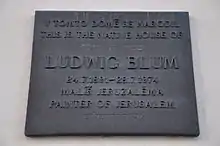Ludwig Blum
Ludwig Blum (1891–1975) was a Moravian-born Israeli painter. He emigrated to Israel in 1923, as part of the Third Aliyah, and became known as "the painter of Jerusalem".
Ludwig Blum | |
|---|---|
.jpg.webp) Ludwig Blum Memorial plaque in Brno-Líšeň | |
| Born | 1891 |
| Died | 1975 Jerusalem, Israel |
| Occupation | Painter |
Early life

Ludwig Blum was born in 1891 in Brno, Margraviate of Moravia.[1][2][3][4] He emigrated to Mandatory Palestine in 1923, as part of the Third Aliyah.[2][3][4] He served in the First World War.[4] He was privately educated in Vienna and later attended the Academy of Fine Arts in Prague.[1][3]
Career

Upon his arrival in Mandatory Palestine, and as a dedicated Zionist, Blum started paintings scenes of everyday life and landscapes in Israel.[3] He did many paintings of Jerusalem (including the Western Wall and the Mount of Olives), Tel Aviv, the Sea of Galilee and the Judaean Mountains.[3][5] Additionally, he painted some kibbutzes: Kiryat Anavim and Degania Alef, and the lives of Israeli soldiers, including the Palmach.[3][6][7] He also painted copper mines in the Timna Valley.[3] He also painted the Arch of Constantine in Rome, Italy, and a vase of roses.
Blum became known as "the painter of Jerusalem".[2][4] In 1933, his painting entitled simply Jerusalem was honoured at the Royal Academy of Arts in London.[1] In 1967, he received the Yakir Yerushalayim from the City of Jerusalem.[1]
In 2011 the Museum of Biblical Art in Manhattan held an exhibition of Blum's paintings.[8]
Selected paintings
- Jerusalem in the Snow (1927).[3]
- Jerusalem, Temple Mount (1928).[3]
- Vase of Rose (1931).[9]
- Kibbutz Kiryat Anavim (1932).[3]
- Kibbutz Degania (1934).[3]
- The Judea mountains (1943).[10]
- The Arch of Constantine (1944).[11]
- Jerusalem, seen from Mount Scopus (1950).[12]
- The Market in Jerusalem (1950).[13]
- View of Jerusalem from the Hill of Evil Counsel (1951).[14]
- Landscape (1956).[15]
- Timna, Copper Mines (1957).[3]
- View of Jerusalem (1962).[16]
- Jerusalem, David's Tower and the Sultan's Pool, seen from Mishkanot Shaananim (1964).[17]
- The Western Wall.[2]
- The walled city of Jerusalem from the Mount of Olives.[18]
- Sea of Galilee.[19]
- Portrait with a keffiyeh.[20]
See also
Further reading
- The Real and the Ideal: The Painting of Ludwig Blum (Tel Aviv: Museum of the Jewish People, 2009).[21]
References
- "Ludwig Blum - Biography".
- "Bonhams : Ludwig Blum (Israeli, 1891-1975) The Western Wall".
- "Printed from The Jewish Press » Blog Archive » Ludwig Blum's Israel".
- "Jerusalem and the Holy Land - MOBiA - Museum of Biblical Art".
- Azaryahu, Maoz; Ilan Troen, S.; Troen, Selwyn Ilan (2012). Tel-Aviv, the First Century. ISBN 978-0253223579.
- Torstrick, Rebecca L. (2004). Culture and Customs of Israel. ISBN 9780313320910.
- Almog, Oz (28 November 2000). The Sabra. ISBN 9780520921979.
- "Jerusalem and the Holy Land: The Paintings of Ludwig Blum (1891-1974)". mobia.org. Museum of Biblical Art. Retrieved 26 March 2015.
- "Bonhams : Ludwig Blum (Israeli, 1891-1975) Vase of flowers".
- "Bonhams : Ludwig Blum (Israeli, 1891-1975) The Judea mountains".
- "Bonhams : Ludwig Blum (Israeli, 1891-1975) The Arch of Constantine, 1944 9 1/2 x 13 1/4in".
- Christie?s. "LUDWIG BLUM (1891 - 1975)".
- Christie?s. "LUDWIG BLUM (1891 - 1975)".
- Christie?s. "Ludwig Blum (1891-1975)".
- "Bonhams : Ludwig Blum (Israeli, 1891-1975) Landscape".
- Christie?s. "Ludwig Blum (1891-1975)".
- Christie?s. "LUDWIG BLUM (1891 - 1975)".
- "Bonhams : Ludwig Blum (Israeli, 1891-1975) The walled city of Jerusalem from the Mount of Olives unframed".
- "Bonhams : Ludwig Blum (Israeli, 1891-1975) Sea of Galilee".
- "Bonhams : Ludwig Blum (Israeli, 1891-1975) Portrait with a keffiyeh".
- The Real and the Ideal. 2009.